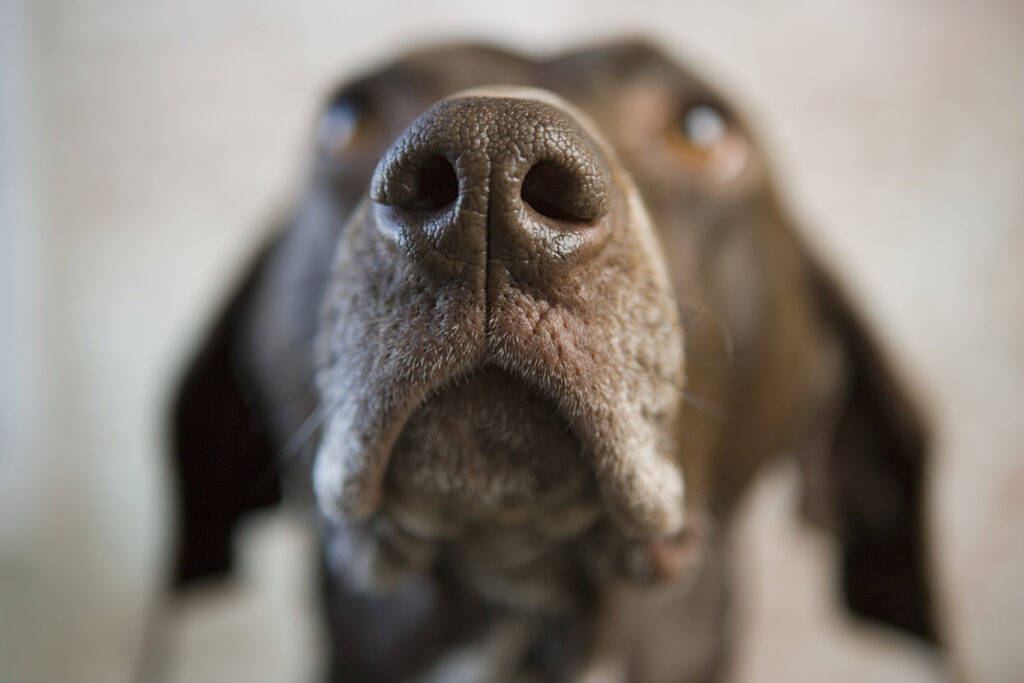What Are Dog Nasal Mites?
Is your dog sneezing more often than usual? Have they had unexplained nosebleeds or been shaking their head more often? If so, they are likely dealing with nasal mites. Dog nasal mites are parasitic creatures that are usually invisible to the naked eye. While your dog may have a large number of mites crawling around their nose, you won’t actually be able to see them.
Any dog breed can have nasal mites and unfortunately, they are extremely contagious. Dogs in confined spaces such as boarding facilities or rescue centers are likely to pass nasal mites to other dogs easily. Learning the signs and symptoms of nasal mites can help you seek treatment right away for your dog and help prevent from spreading nasal mites to other dogs.
What Causes Nasal Mites in Dogs?
While there is no specific cause for nasal mites, they are extremely contagious. Nasal mites spread simply from one dog’s nose touching another dog’s nose. So if your dog has spent time around other dogs or been boarded recently, that is likely the cause for their nasal mite infestation. While nasal mites do not seem to discriminate between breeds, some research has shown that dogs with larger snouts are more likely to have nasal mites.
The mites can often live just on the edge of the nostrils of a dog making it easy to transfer from one animal to another. Dogs often sniff one another when greeting or playing, making it an ideal time for mites to be transferred from one dog to another. Mites need a host site in order to continue reproducing, so your dog is unlikely to get mites just from sniffing the ground. Instead, playing at the dog park or a visit to the vet are more likely to cause nasal mites as they interact with other dogs in those environments.
Symptoms of Nasal Mites
All of the symptoms of nasal mites in dogs will impact either their nose or respiratory system. Nasal mites can cause intense itching in your dog’s nasal passages which in turn causes excessive scratching and itching. Symptoms typically include your dog scratching at their nose often, nose bleeds, reverse sneezing, and shaking their head often. If you notice an unusual amount of discharge from your dog’s nose this is also a common symptom of nasal mites.
Respiratory issues can also be a symptom of nasal mites in canines. Nasal mites can cause labored breathing in your dog as they try and clear the mites. The mites can travel towards the back of the nasal passage near the throat which can also cause your dog to cough often. If you notice any of these symptoms, make an appointment with your veterinarian to have your dog checked for nasal mites.
How to Diagnose Canine Nasal Mites
Although nasal mites will drive your dog crazy with itching and irritation, you likely won’t actually be able to see them. These ting parasites are approximately 1 millimeter long and typically can only be seen with a microscope. Due to their small size, veterinarians often have to use a scope to see them inside the nasal passage. This means that a diagnosis is often made simply from symptoms alone as using a scope is an invasive procedure that requires anesthesia.
Another less invasive option to diagnose canine nasal mites is by collecting a sample of mucus. Sometimes your veterinarian may try and flush the nasal passages to move fluid to the back of the throat making it easier to collect the sample. If a sample is able to be collected successfully, your vet can then observe the sample under the microscope to look for nasal mites.
It is important for a dog to be diagnosed correctly with nasal mites when possible as the same symptoms for nasal mites can be symptoms of more serious conditions.

Treatment for Nasal Mites
Nasal mites can live inside the nose for almost three weeks. This means that getting rid of the mites takes patience and consistency with medication. Antiparasitic medication is typically the first line of treatment for nasal mites in dogs. This medication tends to help up to 85 percent of dogs with nasal mites. The most common medication given to dogs for nasal mites is ivermectin.
Due to the symptoms of extreme itchiness and discomfort, your vet may also prescribe steroids and antihistamines to help relieve those symptoms. If it is a severe case of nasal mites your vet will work to make sure your dog is comfortable and that there aren’t secondary symptoms that are being caused by the mites. Some dogs stop eating if they have major discomfort from the mites. Getting treatment right away is important for your dog’s overall health and well-being.
Recovery from Nasal Mites
As your dog is being treated and recovering from nasal mites, make sure to keep them away from other dogs. Fortunately, humans cannot get nasal mites so you do not have to keep your distance. Remember that nasal mites can live for up to 19 days.
Due to their longer lifespan, it is important to continue and finish all treatments that your veterinarian prescribes. If you notice that your dog still has symptoms after the treatment is completed, make sure to let your veterinarian know right away. It is also important to make sure you have a follow-up appointment to ensure that the treatment worked and your dog is free of mites.
Recap of Canine Nasal Mites
While nasal mites are a major pain for both you and your dog, luckily they are mostly harmless. Nasal mites also tend to be rare for most dogs unless they have been in an environment with other infected dogs. If you notice any symptoms that you think may be indicators of nasal mites in your dog, make sure to seek treatment right away. Acting fast will help stop the spread of nasal mites to other dogs as well as help ease any discomfort your dog has been dealing with due to the mites.
If you believe your dog has nasal mites near Broomfield, CO, contact Broomfield Veterinary Hospital. Call us today at 303-466-1764, or Request an Appointment Online!




